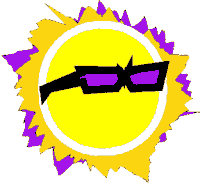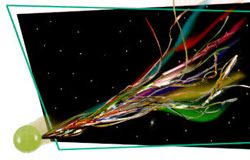BACKGROUND:
 A
star is a ball of burning gases, mostly hydrogen and helium. A star shines or glows because its gravity causes its gases to fuse
together. This process releases energy, hence the "shine". Our Sun
is only a medium-sized star. There are stars that are bigger, smaller,
hotter, and cooler. However, the Earth is very small compared to the Sun.
More than a million Earths could fit into the Sun. All life on Earth depends
on the Sun for light and heat.
A
star is a ball of burning gases, mostly hydrogen and helium. A star shines or glows because its gravity causes its gases to fuse
together. This process releases energy, hence the "shine". Our Sun
is only a medium-sized star. There are stars that are bigger, smaller,
hotter, and cooler. However, the Earth is very small compared to the Sun.
More than a million Earths could fit into the Sun. All life on Earth depends
on the Sun for light and heat.
Until the seventeenth century, most scientists thought
that the Earth was the center of the Universe, mainly because it appears
that way to casual observation. It is quite obvious that the Sun and Moon
travel across the sky from east to west. Ancient people often thought that
the Sun and Moon were gods with chariots such as Apollo and Athena, and gave
them personalities.
Part
of this confusion was because while all sky objects appear bright, some
stars and galaxies (collections of stars) radiate light, while the others
only reflect light. This is sometimes difficult for children to understand as
well. When they look up at the night sky, they see the brightly shining
moon. How can it be that it does not produce its own light, but yet it
shines?
The stars make their own light. The Moon, planets,
asteroids, natural satellites, and comets shine by light reflected from the
Sun. The Moon has no light of its own, so it appears to have phases, cycling
from new Moon to full Moon and back every 29½ days. The phases happen
because of the angle at which the Sun's rays strike the Moon relative to the
Earth, but the exact mechanism will be explained in the later grades.
PROCEDURE:
- In this lab activity, students will learn that bodies in space can be
classified in two many ways: (1) those bodies that produce light (stars)
and (2) those bodies that do not (planets, comets, meteorites, and most
everything else in space).
- A flashlight or an energy ball can be an example of an object that
produces its own light. Show students these items and discuss whether
the light is produced inside or not. A flashlight is like a star. If you
put an object, like a basketball in a dark room, you will not see the
basketball. However, if you shine the flashlight on the ball, you can
see the basketball in the dark. The basketball is the Moon or Earth and
the flashlight is the Sun. You many want to demonstrate this in class.
 Comets also
reflect light from the Sun. A comet is an object that is made up of
gases and "rocks." Comets do not pass Earth very often and
ancient peoples were frightened of them. Give each pair of students one
"comet ball." (A ball with reflective streamers.) Give several
students the energy balls to act as shining stars in the room. Two or
three students should have control of the flashlight to shine it as
students are tossing the comets.
Comets also
reflect light from the Sun. A comet is an object that is made up of
gases and "rocks." Comets do not pass Earth very often and
ancient peoples were frightened of them. Give each pair of students one
"comet ball." (A ball with reflective streamers.) Give several
students the energy balls to act as shining stars in the room. Two or
three students should have control of the flashlight to shine it as
students are tossing the comets.
- Students will have to throw the comets to their partner. Make them
practice several times because when you turn the lights out you want
them to be able to catch the comets. Then turn the lights off and ask
students if they can see any comets when they throw them to their
partner. They should answer no. Next, put several flashlights around the
room, and shine them on the energy balls. Have the students throw the
comets again. Ask them when can they see the comets. They should realize
that the comets are only visible when they come into contact with the
light. The comet is reflecting light, not producing light. The students
using the energy balls are representing stars.